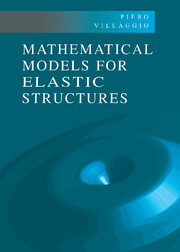Book contents
- Frontmatter
- Contents
- Preface
- Introduction
- Chapter I Basic Concepts
- Chapter II Rod Theories: Three-dimensional Approach
- Chapter III Rod Theories: Director Approach
- Chapter IV Theories of Cables
- Chapter V Theories of Membranes
- Chapter VI Theories of Plates
- Chapter VII Theories of Shells
- References
- Index of Authors Cited
- Index
Chapter I - Basic Concepts
Published online by Cambridge University Press: 11 September 2009
- Frontmatter
- Contents
- Preface
- Introduction
- Chapter I Basic Concepts
- Chapter II Rod Theories: Three-dimensional Approach
- Chapter III Rod Theories: Director Approach
- Chapter IV Theories of Cables
- Chapter V Theories of Membranes
- Chapter VI Theories of Plates
- Chapter VII Theories of Shells
- References
- Index of Authors Cited
- Index
Summary
Density, Motion, and Temperature
Mechanics studies the conditions for the motion and equilibrium of natural objects. In order to treat these in a sufficiently general form, mechanics introduces the notion of the body, which is a mathematical concept designed to give an abstract representation of the most important properties of these physical objects in order to describe their mechanical behavior. By the term “body” we mean a regularly open set $ in some topological space. The elements of a body are called particles, or substantial points to avoid confusion with the term “particle” as used in physics (Truesdell 1991, Ch. I, p.3). Bodies are available in their configurations, which are the regions that they may occupy in Euclidean space at some time. It is commonly assumed that configurations are regularly open sets in Euclidean space and there is a one-to-one mapping between the particles of the body and a possible configuration. It is often convenient to select one particular configuration K and to identify each particle of K by its position in this configuration, called the reference configuration. If, in the reference configuration, we choose Cartesian coordinates, the particle can be designated XA or X, Y, Z.
At the time t varies the particles change their positions in space, and consequently the position of a particle XA at the instant t is characterized by a vector function xi or x, y, z, of the form
which is called the motion of the body. The motion determines the shape of the body at each instant.
The inertia of a particle is determined by a scalar function p = p(XA, t), called the density; and the hotness of a particle is determined by another scalar function Ө = Ө(XA, t), called temperature.
Motion, density, and temperature are regarded as primitive concepts: that is, they need not be defined in terms of other known quantities, and must be measurable, at least in principle. The aim of mechanics is to determine the fields associated with Xi, p, and Ө. However, these quantities are not completely unrestricted, because both density and temperature must be positive-valued functions, and the functions // must be continuous and invertible so as to exclude the possibility of two particles assuming the same position.
- Type
- Chapter
- Information
- Mathematical Models for Elastic Structures , pp. 7 - 60Publisher: Cambridge University PressPrint publication year: 1997



